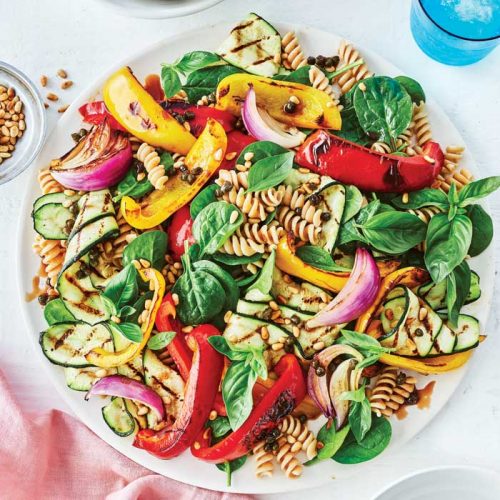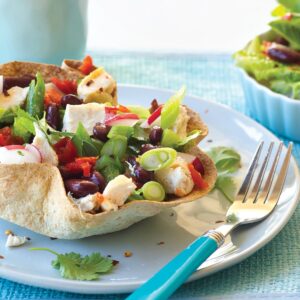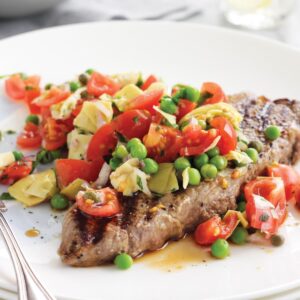
Nutritionist Claire Turnbull shares four steps to a healthier pantry.
Eating well and making healthy choices takes more than just knowing the theory about what foods are good for you and what are best to limit. As well as having a pantry stocked with foods that make it quick and easy for you to put together healthy options, it is important to consider the way your pantry is organised, and the ease of access to different types of food. Here is how to get your pantry in great shape.
Step 1: Stock up with healthy staples
This is a great time of year to go through your pantry and refresh things. Start by emptying everything out and get rid of anything that’s out of date. Then compare what you have with our pantry staples that make meals healthier (right) to see what is missing. While you’re unpacking your pantry, look at how you stack things to see if there is a better way to save space and make things easier to find. Then, over the next few shops, or as finances allow, work on re-stocking your pantry with healthier ingredients.
Pantry staples that make meals healthier
Grains and cereals
Brown rice, arborio rice, wholemeal pasta, egg noodles, bean noodles, wholegrain couscous, quinoa, microwaveable rice pots/pouches: Opt for the wholegrain version of these where you can. They have more fibre, which helps you feel fuller and is important for a healthy digestive system. Noodles and pasta made from beans (eg, black or edamame beans) are a great way to boost the protein in a meal and good for kids.
Having a few pouches or pots of pre-cooked rice (brown or the mixes with quinoa) on hand is ideal for when you’re short on time. Just mix with canned fish and salad or frozen veges.
Oats (wholegrain and rolled): Oats make a quick and easy breakfast. Try porridge, bircher muesli or overnight oats, or you can add them to smoothies. They are also great to use in baking.
Flour (wholemeal, cornflour and alternative flours, such as buckwheat, brown rice, spelt or quinoa): Wholemeal flour is higher in fibre and B vitamins than white flour, so is a better choice, and cornflour helps thicken sauces without needing to make a roux with butter and plain flour. Alternative flours can be nice to use if you have a good recipe that you know works well with them. If you’re a baker, you’ll need some white flour too.
Popping corn: Making your own popcorn is very easy. It’s also cheaper and healthier as you don’t have the added salt and sugar.
Cans and cartons
Fish (tuna, salmon and sardines): Canned fish is a quick and easy way to add protein to breakfast (on toast), lunch (sandwich, wrap or salad) or dinner (fish pie, fish cakes or in a frittata).
Vegetables (tomatoes and beetroot): Canned tomatoes are a staple for so many dishes. Check the labels and look for ones with no added salt.
Reduced-salt stock and tomato paste: Choose low-salt or no-salt versions. Most of us have too much salt and this is an easy way to have less.
Canned legumes (chickpeas, kidney beans, black beans and reduced-sugar-and-salt baked beans): Legumes are packed with fibre, low GI and cheap. Use them to make your own healthy dips, add to mince dishes, casseroles and salads or create meat-free meals.
Dried lentils, split peas and legumes (if you have time to soak and cook your own): Red or yellow lentils are great in a dhal. Brown or Puy (French green) lentils hold their shape so are perfect cooked, then used as the base for a filling salad.
Curry pastes and reduced-fat coconut milk (canned or powdered): Use curry pastes and coconut milk to quickly create a vegetable curry. Compare nutrition labels to choose products lower in sodium and saturated fat.
Long-life milk (or milk powder): It’s always good to have a backup for this essential.
Crackers
Wholegrain crackers: Crackers can make a quick and easy snack or lunch option. Top with canned fish, cottage cheese or avocado and tomato.
Nuts, seeds and dried fruit
Nuts (unsalted almonds, peanuts, cashews, walnuts, Brazils and pine nuts): Nuts are packed with healthy fats, fibre and a variety of vitamins and minerals. Add a few to your breakfast, smoothies and salads, or sprinkle them over stir-fries.
Seeds (pumpkin, sunflower, sesame and linseeds/flaxseeds): Seeds are a healthy snack, just be mindful of your portion size as they are very energy dense. A tablespoon or two is enough for most people. You can also make your own nut and seed butters if you have a good blender.
Dried fruit (figs, apricots, dates and prunes): Use dried fruit in baking or have a small serving with breakfast or as a snack. Keep in mind, dried fruit is a concentrated source of sugar. Dried fruit can be easy to graze on, so avoid making it too accessible in the pantry if you’re tempted to keep nibbling.
Spices, herbs and seasoning
Mixed herbs, mixed spice, cinnamon, cumin, curry powder, paprika and chilli flakes: These are good staples that add flavour with less salt. Keep stock of your favourites, and remember they don’t keep their flavour forever.
Check the ingredients list on spice mixes. For some, salt is the first ingredient, meaning the product has more salt than anything else.
Spreads and sweeteners
Nut and seed butters: These have all the benefits of nuts and seeds, ready to spread on toast. Choose products with no added sugar or salt.
Honey and maple syrup: Honey and maple syrup are useful for baking and making the occasional sweet treat, but they are still ‘free sugars’ so limit the total amount you have.
Reduced-sugar jams: There are jams available now with a higher proportion of fruit to sugar. These are a better choice as most people have more sugar than they need. An easy swap for jam lovers.
Oils
Extra virgin olive oil: A flavoursome oil, especially useful in salads.
Rice bran or canola oil: Good value oils for cooking or salads where you don’t want to add a flavour.
Sesame oil: Adds an Asian flavour to dressings and stir fries.
Oil spray (or in a pump bottle): This helps you to control how much you use.
Sauces and condiments
Vinegars (red, white and balsamic): Vinegars are perfect for dressing your salads.
Mustard, wasabi and horseradish: Best kept in the fridge once open, these are a great flavour boost.
Reduced-salt soy sauce and fish sauce: Soy sauce is very high in sodium, so choose the reduced-salt option and use small amounts. Fish sauce is commonly used in Thai cooking, but is also very high in sodium, so use sparingly.
Reduced-fat mayonnaise: Lower in kilojoules and saturated fat than standard versions.
Drinks
Tea, coffee and herbal teas: Stock decaf options for those who can’t tolerate caffeine or for that afternoon or evening hot drink.
Hot and cold-brew iced teas: There are lots of delicious iced tea bags available that have no added sugar.
Step 2: Organise where things go
The reality is, when you see food, whether you are genuinely hungry or not, you are likely to be tempted to want to eat it. Professor Brian Wansink, of New York’s Cornell University, is renowned for his research into eating behaviour and suggests you are three times more likely to eat the first thing you see, rather than the fifth. So, if the first thing you see when you open your pantry is a bag of chips or biscuits then, by default, you are more likely to eat them than something healthier that is further back and out of sight.
If you have foods in your house such as biscuits and chips, keep them up high, out of sight and out of easy reach. Having to get on a stool to reach them creates a good barrier, and keeps them out of kids’ reach too. Using non-transparent containers for biscuits keeps them out of sight. Or avoid having them in the house altogether, that’s the simplest way to eat fewer of them.
Are you someone who nibbles on the nuts, seeds and dried fruit in the pantry? Or do you have them out on your kitchen bench and eat more than you probably need? If so, try moving these up a shelf in the pantry, or put them into a harder-to-reach non-transparent container. While these can be healthier snacks than other foods, if you eat them just because they are there, and not because you are genuinely hungry or in need of food, that’s not ideal.
Have a healthy snack area in your pantry as your go-to for an after work or lunchbox snack. Include individual servings of nuts and seeds, plain popcorn, wholegrain crackers and small cans of fish. It’s also good to have a fruit bowl where you can see it, so that fruit is easier to reach than snack bars.
And what about the fridge?
Apply the same pantry principles to your fridge.
- Put these foods at the front so they are the easiest to see and reach for when you’re hungry: chopped veges, vege soup, fresh fruit, unsweetened yoghurt, cottage cheese and healthy dips
- If you’re aiming to have fewer alcoholic drinks, a beer or wine fridge in the garage or outside is more helpful than having them in your kitchen fridge. Alternatively, keep alcoholic drinks out of the fridge altogether to tame mid-week drinking. Warm white wine or beer is far less appealing. Keep red wine or spirits out of sight and out of easy reach
- Have still or sparkling water in bottles or jugs in your fridge door so you have something chilled and ready to drink. Flavour the water with iced tea bags, sliced fruit, cucumber or mint to make it more appealing
- Keep blocks of cheese and any treats you might nibble on at the back, in non-transparent bags or containers or up high.
You can now buy reusable food wraps made from fabric and beeswax, which are a great way to use less plastic wrap and make food slightly less easy to see, which can be a good thing.
Step 3: Stack it right
Having everything fall out of the pantry every time you open the door can be a real pain. Look at getting transparent airtight containers that are easy to stack and label. Keeping things in airtight containers will help them last longer. And don’t forget a few non-transparent containers to store treat food up high, out of sight.
Some food we keep in the pantry might be best kept elsewhere, to prolong the shelf life:
- If you buy nuts or seeds in large quantities, it might be best to keep only a small amount in your pantry. Store the rest in your fridge or freezer to keep them fresher for longer. They are high in fat, so can go rancid easily
- Chutneys and jams are much better off in the fridge
- Check the back of your sauces and condiments. Some are okay in the pantry, others would be better refrigerated.
Step 4: Plan and save
Once you have your pantry set up and ready to go, the goal is to keep it that way. Before you go shopping, have a good look through what you have already.
When you plan your meals, not only is it quicker and easier during the week to get dinner on the table and pack a healthy lunch, it can save money too. When you know what you need to buy, you’ll probably waste less food.
Click to download our Healthy Pantry Checklist
www.healthyfood.com










